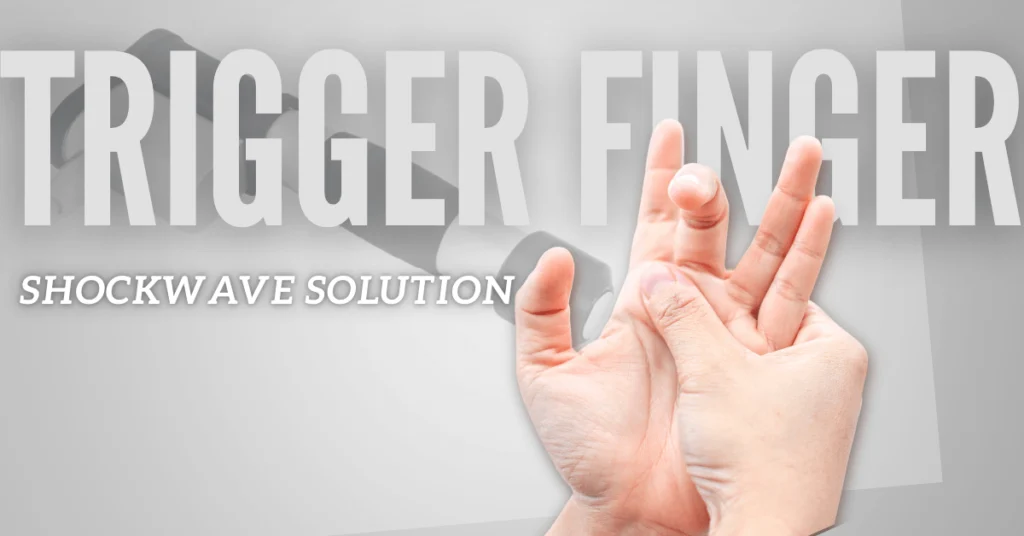Understanding the Mechanism and Treatment of Trigger Finger Pain
Are you tired of dealing with the excruciating pain and inconvenience caused by trigger finger? Look no further! In today’s blog post, we will dive into the fascinating world of trigger finger pain, uncovering its intricate anatomy and unraveling the mysterious mechanism behind it. Get ready to embark on a journey of understanding as we explore every nook and cranny of this common yet enigmatic condition. Brace yourself for an engaging read that will leave you enlightened and armed with knowledge to combat your trigger finger woes like never before!
Shockwave Therapy for Trigger Finger Treatment

Shockwave therapy is a new, non-invasive treatment for trigger finger pain that is showing great promise. This therapy uses high-energy sound waves to stimulate healing and promote blood flow to the affected area. Shockwave therapy has been shown to be effective in treating other conditions such as tendonitis and plantar fasciitis, and is now being used to treat trigger finger pain with success.
There are several benefits of shockwave therapy for trigger finger treatment. This therapy is non-invasive, meaning there is no surgery or needles involved. It is also a relatively short treatment, taking only about 10-15 minutes per session. Most importantly, shockwave therapy has been shown to be effective in reducing pain and restoring function in patients with trigger finger pain.
“rESWT is an effective method to decrease pain severity and improve general functional capacity, range of motion, grip strength, and pinch strength in patients with trigger finger.” – NIH Study
If you are suffering from trigger finger pain, contact us to find out if shockwave therapy is a potential treatment option for your finger or wrist joint pain in San Antonio, FL.
Overview of Trigger Finger Pain
It is estimated that about 1% to 2% of Americans may develop trigger finger at some point in their lives, but in the diabetic population, it rises to 10%. The condition is more common in women than men, and it is also more common in people over the age of 40. Trigger Finger is scientifically known as stenosing tenosynovitis.
There are a number of factors that can increase your risk of developing trigger finger, including:
- Occupations or sports that involve repetitive hand use
- Medical conditions such as diabetes, rheumatoid arthritis, and gout
- Injury to the finger or thumb
- Pregnancy
The symptoms of trigger finger can vary from mild to severe. In mild cases, the person may only experience occasional stiffness or pain in the affected finger or thumb. In more severe cases, the finger or thumb may become locked in a bent position and require manual assistance to straighten it.
Anatomy of Trigger Finger and How It Causes Pain
When a trigger finger is in the bent position, the A1 pulley sits over the top of the A2 pulley. This puts pressure on the tendon, causing pain. The A1 pulley is also what allows the tendon to glide smoothly as the finger bends. If this pulley becomes too tight, it can cause the tendon to catch or snap as it tries to glide past. In some cases, the A1 pulley may need to be released surgically in order to relieve trigger finger pain.

The anatomy of trigger finger and how it causes pain is quite interesting. The mechanism involves the tendons in the fingers and hands that help move the fingers. The sheath that surrounds these tendons is what becomes inflamed when trigger finger occurs. This inflammation makes it difficult for the tendon to move smoothly within the sheath, causing the finger to lock or catch when trying to straighten it out. The pain is caused by this inflammation and can range from mild to severe, depending on the individual case.
Common Causes of Trigger Finger Pain
There are many different things that can cause trigger finger pain. In most cases, it is caused by an injury or repetitive motion. However, there are other conditions that can lead to trigger finger pain as well. Here are some of the most common causes:
Injury:
An injury to the hand or fingers is one of the most common causes of trigger finger pain. This can happen if you fall and land on your hand, or if you hit your hand on something hard. Repetitive motions with the hands and fingers can also lead to trigger finger pain.
Arthritis:
Arthritis is another common cause of trigger finger pain. This is because the arthritis can cause the joints in the fingers to become inflamed, which can lead to pain when trying to move the fingers.
Bone Spurs:
Bone spurs can also cause trigger finger pain. These are small growths of bone that can form on any bone in the body, including the bones in the fingers. They can make it difficult to move the affected finger, and they can also be quite painful.
Diabetes
In people with diabetes, the lining of the tendon sheaths can thicken and become inflamed. This can make it difficult for the tendons to slide smoothly through the sheaths, resulting in a condition known as tenosynovitis. In some cases, the tendon can become so inflamed that it gets stuck in the sheath, causing the finger to lock in a bent position. This is known as trigger finger.
Treatment Options for Trigger Finger Pain
There are a number of different treatment options available for trigger finger pain. The most appropriate course of treatment will depend on the underlying cause of the condition.
If trigger finger is caused by an injury or overuse, rest and ice may be all that is needed to alleviate symptoms. If the condition is caused by arthritis or another medical condition, more aggressive treatment may be necessary.
Corticosteroid injections are often used to treat trigger finger pain. These injections can reduce inflammation and help relieve pain. Surgery is sometimes necessary to release the tendon that is causing the problem.
Trigger finger splints are also commonly used to treat the condition. These splints keep the affected finger in a straight position and allow it to rest and heal. Physical therapy may also be recommended to help stretch and strengthen the affected tendons and muscles.
Conclusion
Understanding the anatomy of trigger finger pain can help us better sympathize with those who suffer from it. By understanding what causes the condition, we can create more effective treatments and preventative care that will minimize their risk for developing this painful condition in the future. While much more research needs to be done on trigger finger pain, by exploring its anatomy, we are one step closer to helping those who are affected by it.
References:
Dogru M, Erduran M, Narin S. The Effect of Radial Extracorporeal Shock Wave Therapy in the Treatment of Trigger Finger. Cureus. 2020;12(6):e8385. Published 2020 Jun 1. doi:10.7759/cureus.8385

